We’re at the end of summer when the bounty of the season is in full swing. Time to start preserving the harvest in any and every way. Canning and freezing are the most common ways to do this, but don’t forget about dehydrating! Here’s how to dehydrate peppers for food storage.
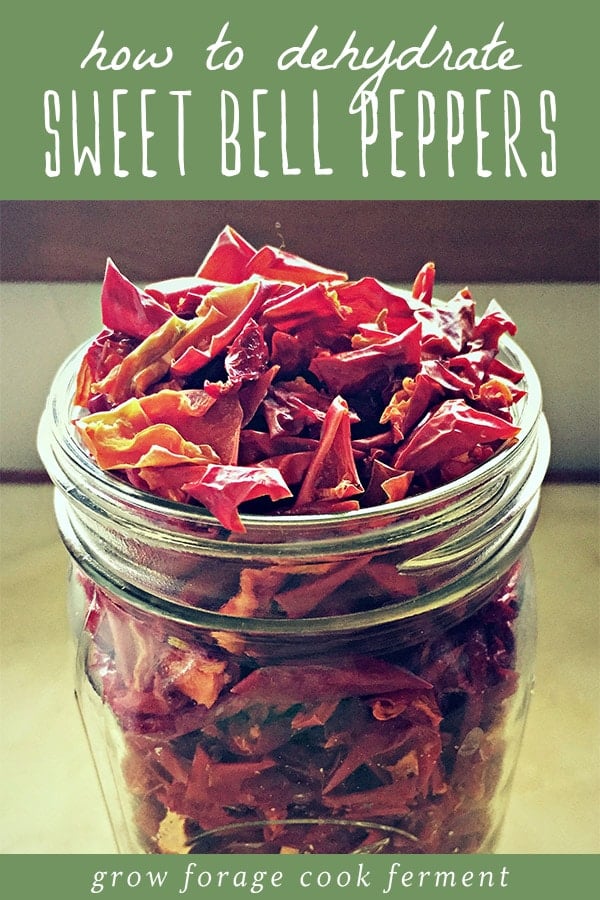
Want to save this post for later?
Why Dehydrate Vegetables?
The best part about dehydrating is that you can take a huge amount of produce and reduce it down to a very small container, with all of the vitamins and minerals still intact.
When you’re ready to use the dehydrated veggies, just add hot water to rehydrate!
They won’t have quite the same consistency as when fresh, but can still be used for many things, such as soups, stews, pasta or rice meals.
They also can be combined with other dried ingredients to make meals for camping or backpacking, or just for storing in your pantry.
Peppers, onions, garlic, mushrooms, and tomatoes all dehydrate very well, as do most fruits.
For a great guide on dehydrating fruits and vegetables, I recommend The Ultimate Dehydrator Cookbook!
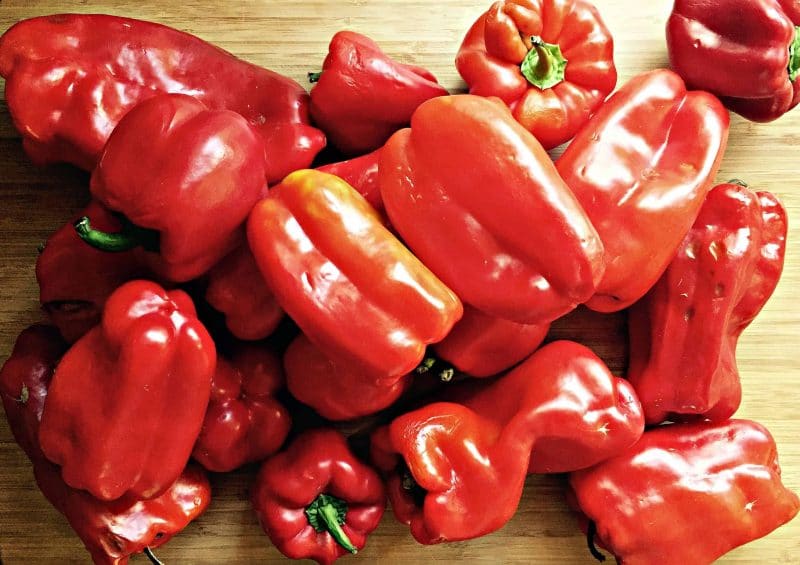
Get more recipes for canning, fermenting, quick pickling, dehydrating, and freezing so that you can enjoy your summer produce year-round in my ebook Preserving the Garden Harvest!
How to Dehydrate Bell Peppers
Dehydrating is a simple and effective way to preserve peppers for storage, whether it be for a short or long term.
Sweet bell peppers from the garden are a treat, and they are also one of the easiest veggies to dry. They are the perfect vegetable to start with if you are just learning how to dehydrate!
The first step is to remove the seeds and dice the peppers into relatively uniformly sized pieces.
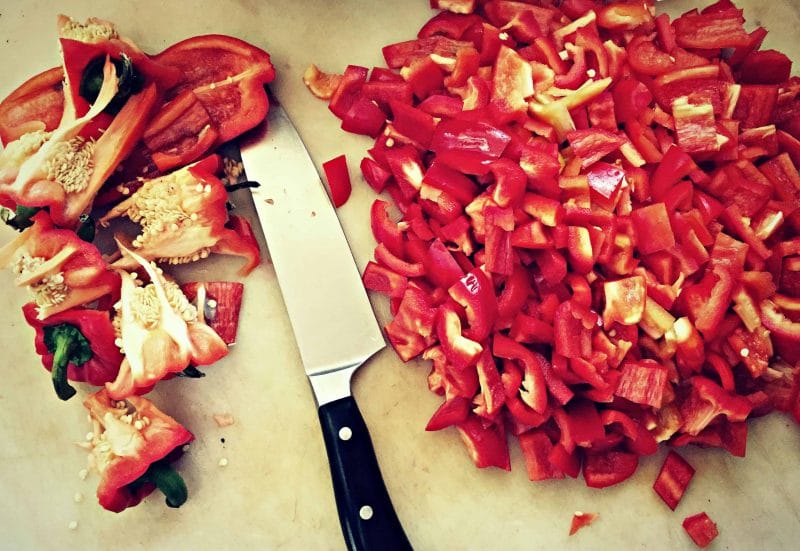
This is a great time to think about saving your seeds for next years planting, as you will have a lot of them!
Simply put some aside into a little bowl to dry out before storing.
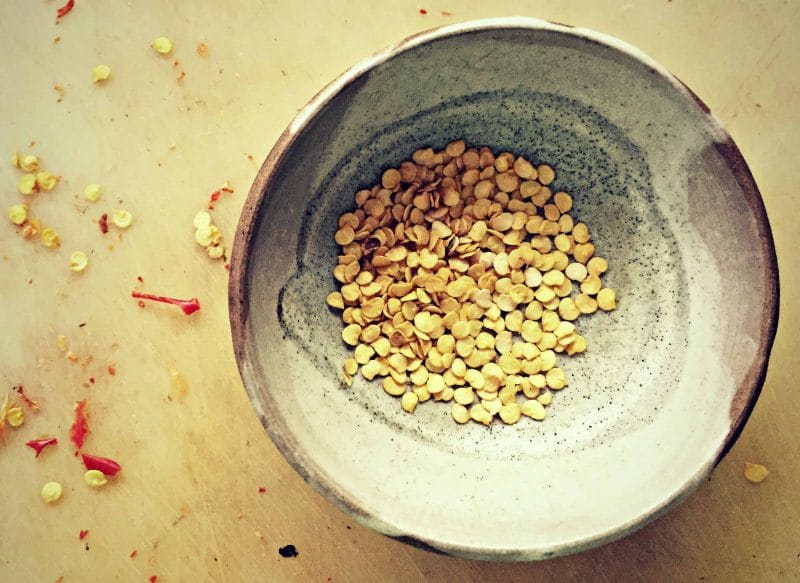
Spread the pepper pieces in a single layer on a dehydrator tray.
When choosing dehydrators, I more than highly recommend the Excalibur Dehydrator. Definitely go for the 9 tray model as it can do so much more at one time.
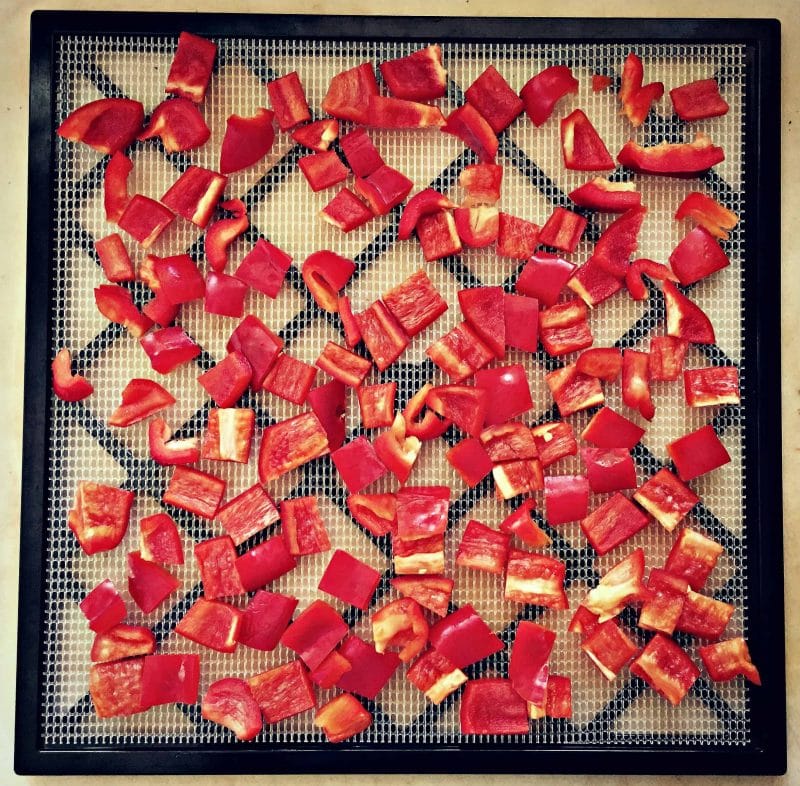
I also use my dehydrator for many different applications besides simply drying veggies and fruits such as zucchini chips and apples, making yogurt, drying medicinal herbs, making infused oils, and making homemade tempeh.
I love my Excalibur dehydrator and have never been disappointed in my purchase!
Put the tray of peppers in your dehydrator.
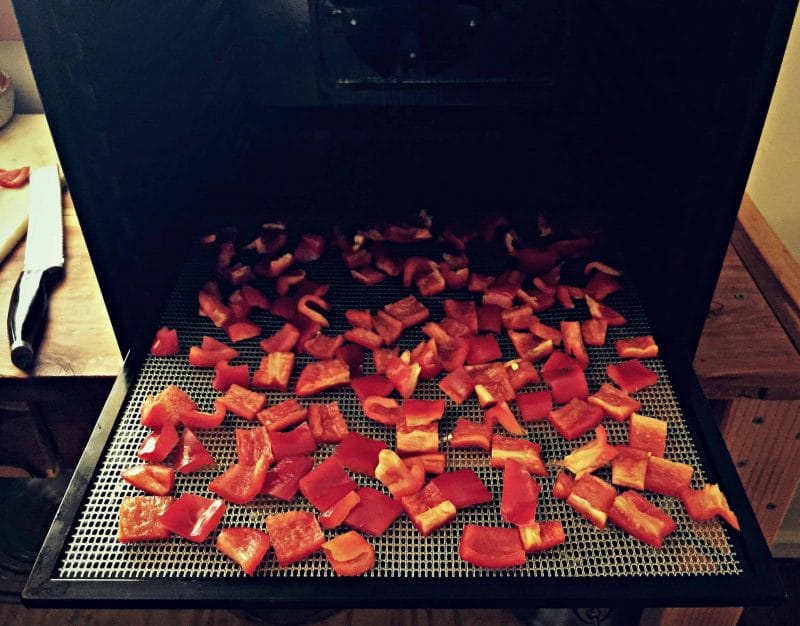
Repeat the process until you’ve used up all the peppers!
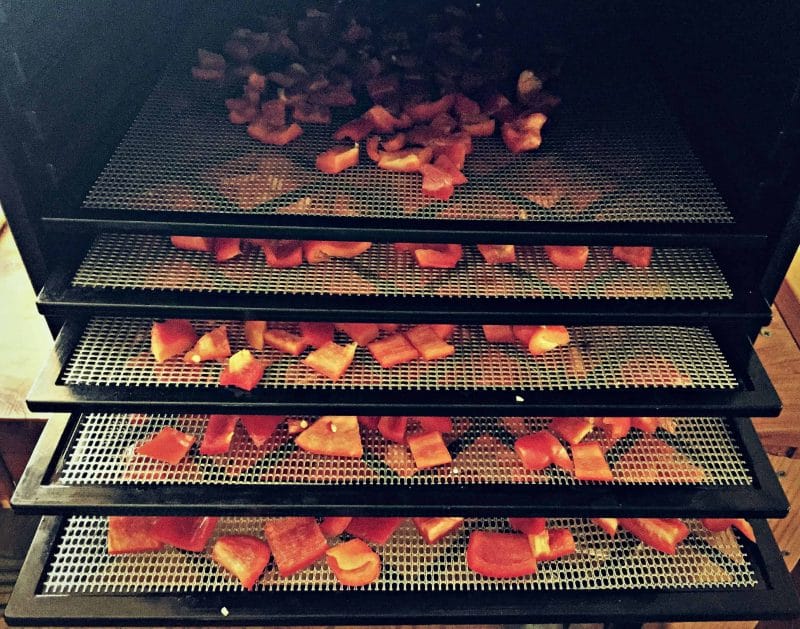
Push the trays all the way in and put the cover on the dehydrator.
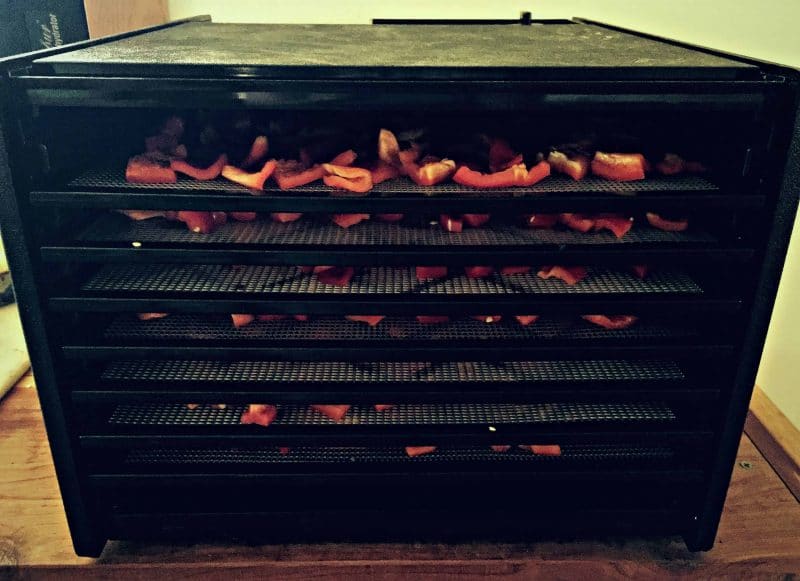
Dehydrate the peppers at 125°F for 12-24 hours.
It took about 18 hours for mine to be fully dehydrated, but it will depend on the heat and humidity in your location, and also how juicy your peppers are to begin with.
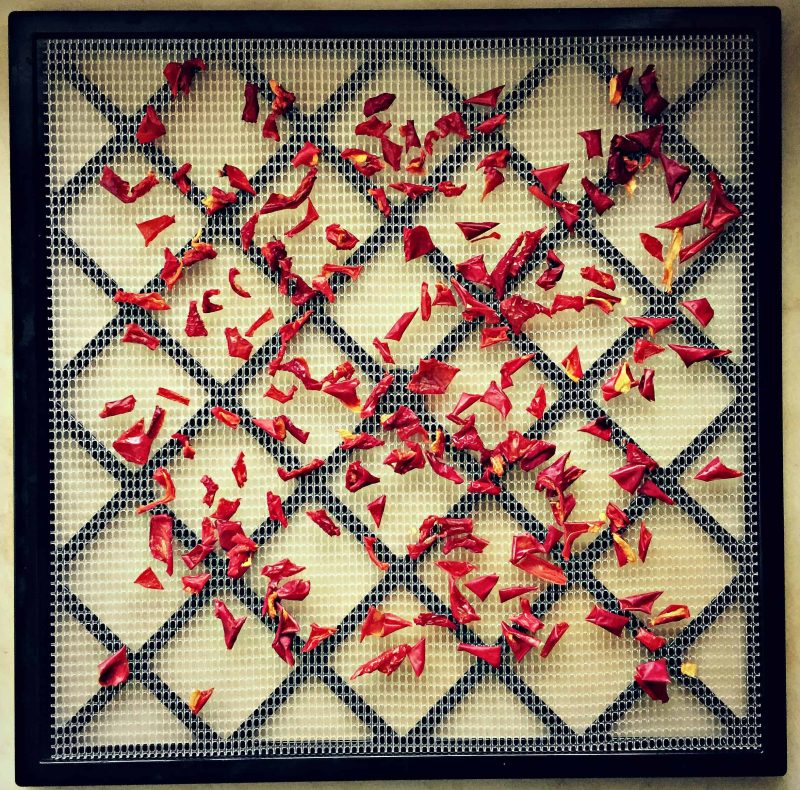
They shrink down quite a bit! Make sure they are completely dry and do not have any softness to them whatsoever, especially if you are using them for long term food storage.
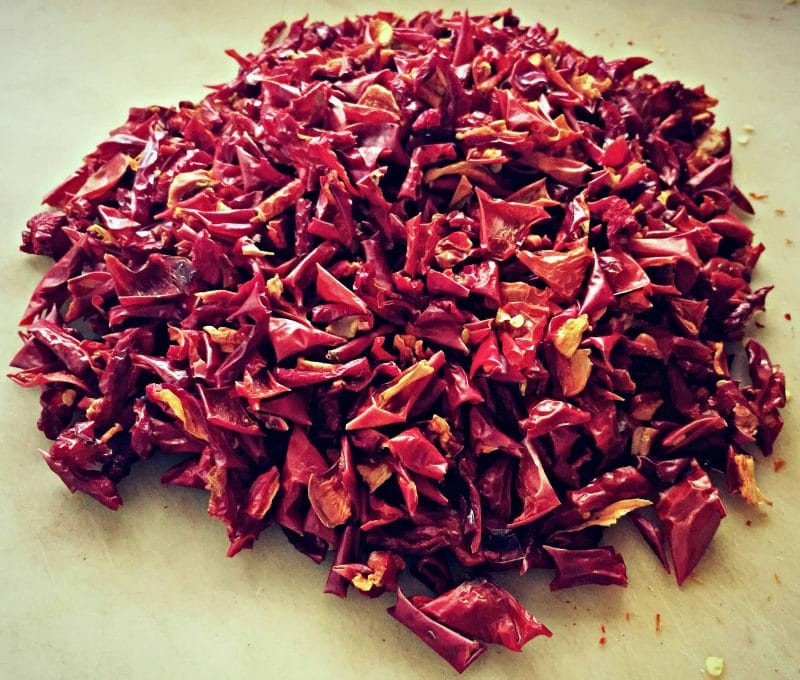
All of those peppers I started with turned into one fully stuffed quart of dried peppers. That’s pretty amazing if you ask me!
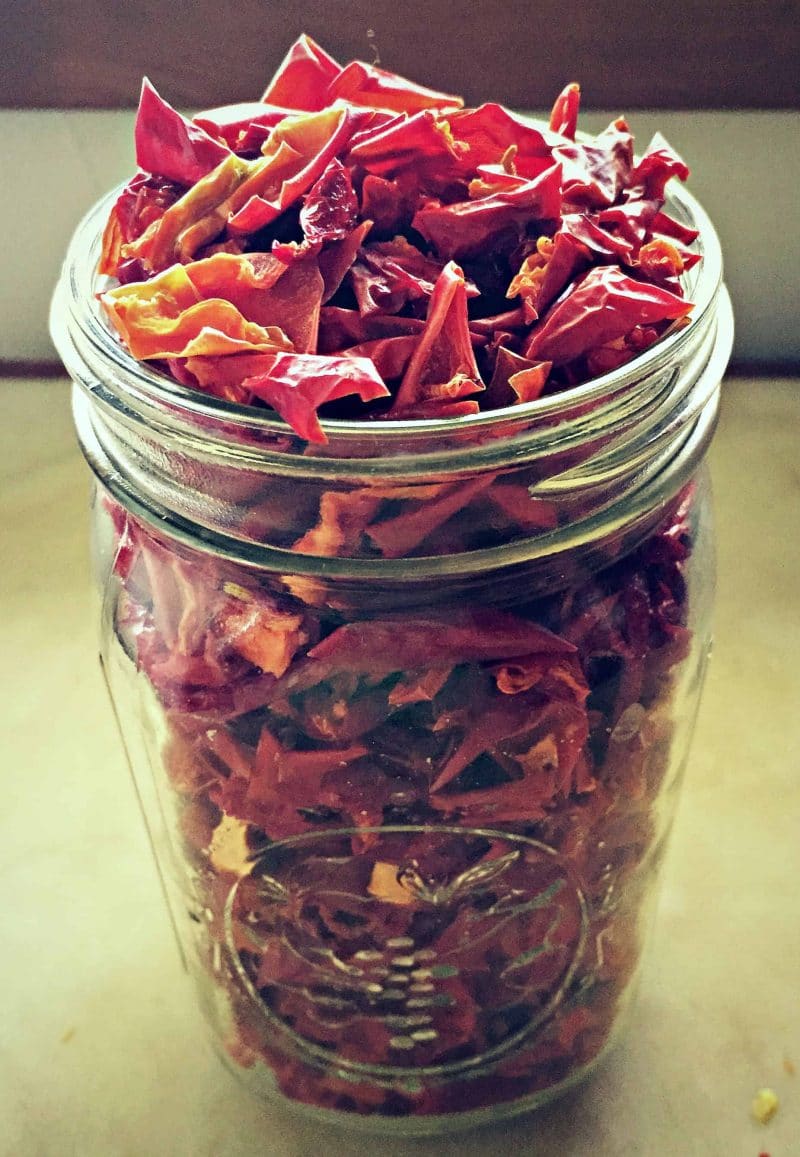
How to Use Dehydrated Peppers
These dehydrated peppers are perfect for putting in your pantry and grabbing a handful here and there as needed.
All you need to do is add hot water to rehydrate them! They are great to add to soups, stews, pasta or easy camping meals.
This black bean soup recipe uses dried peppers as well as other dried veggies.
I like to mix together dried peppers and other dried veggies with couscous in a jar and keep it in the pantry for a quick meal. All you have to do it add hot water and let it sit for 10 minutes or so.
Add a little olive oil, seasonings of your choice, and protein (can be leftovers or even a can of tuna) and you’ve got an easy dinner! Not to mention it makes a great gift in a jar.
It’s so nice to be able to eat your homegrown veggies year-round!
Time to add dehydration as one of your food preservation methods, you won’t regret it!
More ways to preserve peppers:
- How to Make Pepper Jelly: Mild or Hot
- Pickled Jalapeño Peppers: Quick Refrigerator Recipe
- How to Oven Roast Hatch Chile Peppers
- Fermented Pepperoncini Hot Sauce
- Fermented Jalapeño Hot Sauce
- Quick Pickled Peppers Recipe
Dehydrated Bell Peppers
Equipment
Ingredients
- 20 bell peppers approximately (can do more or less based on what you have)
Instructions
- Remove the seeds and dice the peppers into relatively uniformly sized pieces.
- Spread the pepper pieces in a single layer on a dehydrator tray. Put the tray of peppers in your dehydrator.
- Repeat the process until you've used up all the peppers. Push the trays all the way in and put the cover on the dehydrator.
- Dehydrate the peppers at 125°F for 12-24 hours.
- Make sure they are completely dry and do not have any softness to them whatsoever, especially if you are using them for long term food storage.
- Store the dried peppers in a mason jar.
Notes
Nutrition

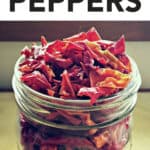


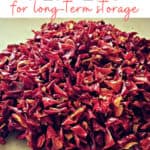
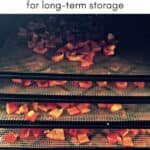
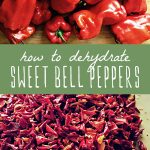
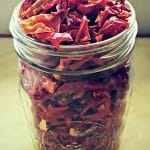

After dehydrating peppers, put them into a blender or coffee grinder and turn them into powder. Store in a spice jar and add to soups, stews, sandwiches, omelets, pizza, dips, chili, etc. You can do this with any dehydrated vegetables.
i don’t have a dehydrator, can I use my oven?
It should work in the oven at its lowest temperature.
will it last a year after drying?
Yes, properly dehydrated peppers can last up to a year in your pantry.
My dehydrated green peppers turned brown in the dehydration process. Is that normal?
Hi Bobbie. It may mean that they didn’t dry properly.
Lower the temperature, citrus will do that too lower the temperature increase time
Is it possible to do this in the oven with the same temperature and time? Would it work on a baking tray?
It should work in the oven at your lowest temperature.
Can you dehydrate pureed peppers?
Yes but you will end up with a hard sheet (when fully dry) that you can break apart for storage in canning jars and later re-hydration. If you do dehydrate a puree make sure you use a silicon sheet on your dryer rack at least until your product is dry enough to peel off before placing on the mesh tray to finish drying. Otherwise your dehydrator will be a mess!
To be fully storage ready the final product shouldn’t be sticky to the touch or you have too much moisture and it won’t store safely. Use a food sealer with canning jar attachment and oxygen absorbing packet then store in a cool dry place.
Tip – the thinner and more uniform the puree is spread on your silicon sheet the shorter your dry time will be. Good luck!
I glad I found this website of yours. Two years ago I cut up and froze a bunch of green peppers from my garden. I had a bumper crop from just a couple of plants. But they take up so much room in my small freezer. Dehydrating them is a no brainer. I will give this a try this year. Thank you
When we dehydrate the peppers, should we remove the seeds and even stems and membranes? After finishing the preserve process, the pepper can be used longer than an year, can’t it?
Can you share your infused oil recipes used your dehydrator ?
such a great idea, I have been wondering what to do with my peppers (hot) besides just blanching them and freezing them, so on your recommendation I JUST cut, de-seeded and have my dehydrator going!!
I would like to ask about tomato’s, gosh it is hard to get out those slimy seeds and put them somewhere to dry, I need help! I take a lid type thing, and scoop them gently out after I cut them, or sometimes just use those that mess up my cutting board, I dried some tomato’s today too (put them on the bottom shelf, anyway, suggestions for drying tomato seeds?
also, anyone ever dehydrate eggplant? seems like they are so tender, not good for blanching, but what about drying them and again, what about the seeds??
so many questions…..
Also isn’t it funny how soils are different everywhere?? I had a bumper crop of zuc’s, enough to feed a third world nation, ( never considered dehydrating them, the blanching is such easy access). But back to soil. for some reason this year in my raised bed garden I didn’t get my onions to grow!! or my garlic??? I mean they usually are a give, and a necessity for my cooking. So maybe my soil didn’t have something necessary? I also know my garden wasn’t deep enough for carrots!! I’ll change that next year.
Just started some more tomato’s since we are in a drought I should be able to get a whole bunch more out of this season.
Love reading your Posts Colleen, wish I could do all you suggest, someday, sometime maybe I will come visit during harvest and just pick your brain!!
suzie